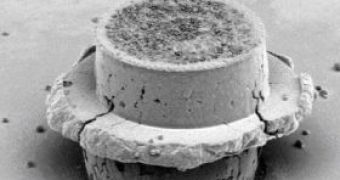The ever-powerful computing devices need more and more circuit connections, which ultimately translates in longer links between individual electronic components, fact that determines frequency loss and an overall drop in performance, partially canceling the technological advancements obtained over time. In computer microchips, this is mostly determined by the fact that vertical connections between chips and boards are made by melting solder, bonding the two copper pillars. Additionally, to create even stronger bonds, the whole process often requires glue to keep the two chips into place.
And here is the problem, solder is not strong enough for such a task, further still tin solder is not nearly as conductive as copper metal. Researchers from Georgia Tech's School of Chemical and Biomolecular Engineering, led by professor Paul Kohl, say they have succeeded in improving the method of bonding individual copper rods, which should create stronger connections, to increase the amount and the speed of data sent throughout a computer. The technique was presented in the fall, last year, at the Materials Research Society.
Kohl says that copper and tin solder cannot tolerate very large misalignments, as two copper pieces are bonded together, unlike the new all-coper bonding method developed by his team. The bonding process consists of electroplating a so-called bump of copper on the surfaces of both copper pillars, after which they are being hardened through heating that takes place in an oven for as long as an hour, at a temperature of 180 degrees Celsius. This process is critical, as copper pillars measuring less than one millimeter in height are very fragile in normal temperature and pressure environments, and can develop fabrication defects.
Upon measuring pillar defects, graduate student Tyler Osborn realized that the misalignments between the individual copper bumps were less severe than those experienced with solder, which also gives the bond more flexible and mechanically reliable properties, without a drop in electrical conductivity or high frequency noise signals.
Georgia Tech School researchers are routinely collaborating with electronics manufacturer giants, such as Texas Instruments or Intel, and have presumably developed an improved transmission-line fabrication method as well. By applying an epoxy fiberglass substrate onto copper lines and coating the substrate with another polymer, they have been able to create a special configuration of two polymers, one which disintegrates while exposed to ultraviolet light, whereas the second hardens. Then, the line receives an additional titanium and copper coating, after which is it heated in an oven at 180 degrees Celsius. During this time, the polymer substrate decays into carbon dioxide and acetone, creating an air pocket inside the line.
This helps reduce the loss of frequency and also enhances the electrical properties of the line. Researchers report that currently they are working on creating a coaxial cable for chip-to-chip signal transmission, which will further reduce high-frequency noise and increase the maximum signal frequency that can be carried through such lines.

 14 DAY TRIAL //
14 DAY TRIAL //